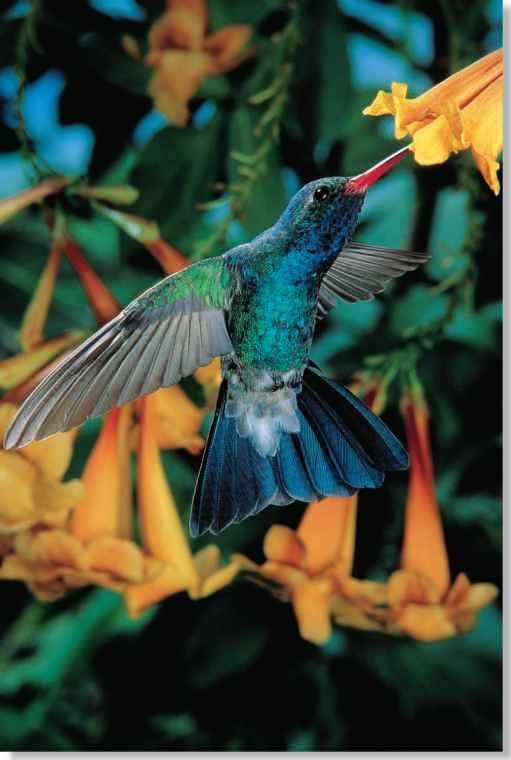ORDER
Apodiform.es
FAMILY
Trochilidae
GENUS & SPECIES
KEY FEATURES
• Eats more insects than most other hummingbirds
• Brightly colored bill distinguishes it from other hummingbirds
• only the female builds the nest, incubates the eggs and cares for the young
• Moves up, down, forward and backward while hovering in the air among flowers
WHERE IN THE WORLD?
Found in North America in northern and central Mexico; also in the U.S. in parts of southeastern Arizona, southwestern New Mexico and western Texas
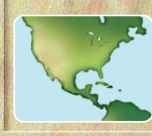
Lifecycle
The broad-billed hummingbird’s brilliant colors flash in the sunlight, as the bird darts from flower to flower to collect nectar or when the male displays to females.
HABITAT
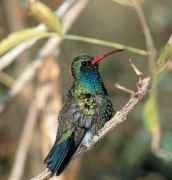
A Perch and search A male broad-billed hummingbird scans for new flowers.
The broad-billed hummingbird is primarily a Mexican species; its range barely enters the U.S. in southeastern Arizona, southwestern New Mexico and western Texas. Whether in Mexico or the U.S., it inhabits stands of sycamore and mesquite trees at the base of mountain canyons. It also dwells in foothills in arroyos (dry gullies) and along the banks of streams.The bird also frequents gardens and residential areas,always searching for new foraging sites that are full of flowers. In the fall, when the weather turns cooler, the hummingbirds that venture as far north as the U.S. return to Mexico for the winter
BREEDING
Broad-billed hummingbirds that migrate north to the U.S. for breeding arrive in March and April, but do not form bonded pairs. The males display for the females, showing off the iridescent markings on their throats in the sunlight in order to attract a mate. After mating, the male flies off to find another female, leaving the first female to build the nest alone.The broad-billed female uses grasses, bits of leaves and bark She forms a small cup, usually on the branch of a small tree about 4-7′ above ground, and lays her two white eggs.
After a 17-20-day incubation, the young hatch — naked, blind and totally helpless. But they have well-developed crops, and shortly after they hatch, the female begins pumping extraordinary amounts of food, both tiny insects and nectar; into her young. Even after fledging, the female continues to feed the young birds for an additional 20-40 days. In the U.S., the breeding season lasts from April to August, and a second nesting attempt is common; due to the warm weather, a third is not uncommon in the long tropical breeding season in Mexico.
FOOD & FEEDING
Like all hummingbirds, the staple of the broad-billed hummingbird’s diet is nectar Favorites include paintbrush plants (Castilleja) and the red blossoms of the ocotillo plant. For most of the year, the ocotillo is bare and thorny, but as soon as the spring rains arrive, scarlet flower clusters appear at the branch tips — just in time for the broad-billed hummingbird’s spring arrival in the U.S. The hummingbird is able to hover and also move forward or backward to reach the sweet fluids nestled inside flowers. After inserting its bill into the flower; it opens its bill slightly and darts its tongue into the fluid.The long tongue can be extended the same length as the bill; when it is pulled back into the bill, the nectar is scraped off of the tongue.The tongue flicks in and out with great speed, from 10-15 times per second. The broad-billed hummingbird’s specialized bill enables it to catch insects as well as sip nectar Aphids, leafhoppers, root gnats, flower flies, ants, parasitic wasps and daddy longlegs are all captured either by hovering in flight, gleaning from the vegetation or stealing from spider webs. All hummingbirds expend great amounts of energy and must eat over 50% of their bodyweight in food each day Hummingbirds, like all birds, only have about 50 taste buds — 1% of the number found in human tongues. But this amount is enough for them to differentiate between liquids. They choose the one highest in sugar — the sweetest.
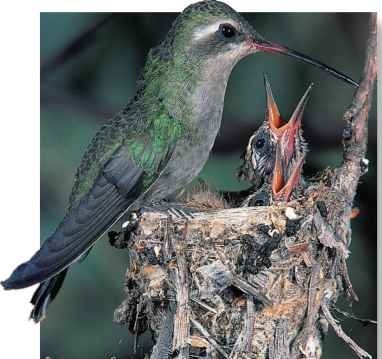
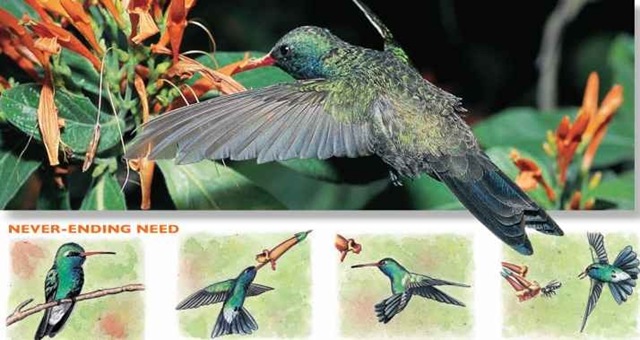
1 if Still hungry…
A male takes a brief break It remains in one place since its feet are designed only for perching.
2 Forward…
Most of the hummingbird’s diet is nectar; it eats over half its bodyweight in food each day.
3 Backward…
A hummingbird expertly backs away from flowers by tilting the leading edges of its wings to the rear.
4 Insects too
Its broad bill enables it to catch larger insects as well, such as a fly that comes too close.
CONSERVATION
The broad-billed hummingbird is currently not endangered. It has easily adapted to the lack of suitable flowers in some of its range by frequenting gardens and residential areas, where humans often leave sugar water in hummingbird feeders to supplement their nectar diet.
Ready for more Two young chicks beg for more insects and nectar.
Many women in the 19th century wore stuffed hummingbirds on their hats; London, Paris and New York imported 400,000 birds each per year.
In all but three or four species of hummingbird, males do not even know the location of their mate’s nests.
# Hummingbirds have the largest breast muscles of all birds relative to body size.
BEHAVIOR
Broad-billed hummingbirds reach the U.S. only in the spring. In September and October; they migrate south to Mexico. Some birds are residents year-round in Mexico, preferring to bypass the migration, which requires extra energy A hummingbird appears quite blurry in flight, since its wings are moving from 22-78 beats per second. The bird’s shoulder joint can be rotated just like a human’s wrist. The hummingbird has large breast muscles for power; it is the only bird whose upstroke of the wing provides as much power as its downstroke. The broad-billed hummingbird takes advantage of its fast speed and small size to evade predators, including hawks.
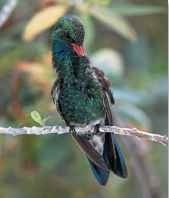
A Stretch and peck A male cleans his brilliantly colored feathers.
PROFILE
Broad-billed Hummingbird
Though its brightly colored bill is adapted for catching insects, the broad-billed hummingbird also hovers near flowers to sip nectar.
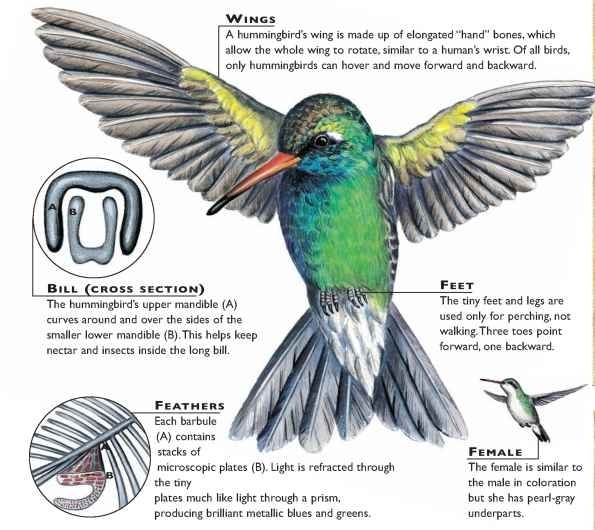
CREATURE COMPARISONS
Measuring 7″ in length from bill to tail, the sword-billed hummingbird (Ensifera ensiferd) is larger than the broad-billed hummingbird. Its 4″-long bill is its distinguishing feature.The green, yellow and
brown sword-billed hummingbird has the longest bill, relative to its size, of any bird. It uses this “sword” to reach the nectar of trumpet-shaped flowers, including fuschias. Found farther south than its relative, the sword-billed hummingbird inhabits the Andes, from Venezuela and Colombia southwest through Ecuador; Peru and Bolivia.
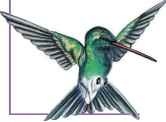
Broad-billed hummingbird
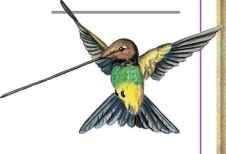
Sword-billed hummingbird
| VITAL STATISTICS | |
| Weight | Less than 1 oz. |
| Length | 3.5-4.5″ |
| Wingspan | About 5″ |
| Sexual Maturity | About 1 year |
| Breeding Season | Varies according to region |
| Number of Eggs | 2 |
| Incubation Period | 15-20 days |
| Fledging Period | About 22 days |
| Breeding Interval | Up to 3 clutches per season |
| Typical Diet | Nectar and insects |
| Lifespan | Unknown |
RELATED SPECIES
• The broad-billed hummingbird is 1 of 315 species within 112 genera in the family Trochilidae the second largest bird family in the New World. Hummingbirds range in length from 2.25-8.5″ and can be found wherever nectar-producing flowers blossom. The smallest hummingbird found in North America is the calliope hummingbird, Stellula calliope, measuring only 3.5″ from bill to tail.
